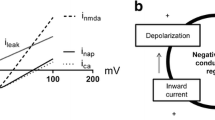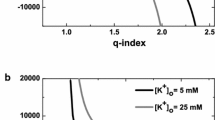Summary
The depolarization that develops after covalent attachment of trimethylammonium benzoyl to the dithiothreitol-reduced frog sartorius acetylcholine receptor is accompanied by a small increase in voltage fluctuations. The amplitude of the elementary voltage event produced by the covalently attached activator is about 0.04 μV, almost an order of magnitude below the acetylcholine shot-effect amplitude in the control preparation, and about one-fourth the acetylcholine shot amplitude after disulfide-bond reduction. Spectral density plots of trimethylammonium-benzoyl noise can be analyzed in terms of two relaxation rates that bracket the single rate observed in response to acetylcholine.
Similar content being viewed by others
References
Adams, P.R. 1974. Kinetics of agonist conductance changes during hyperpolarization at frog endplates.Br. J. Pharmacol. 53:308
Adams, P.R. 1977a. Relaxation experiments using bath-applied suberyldicholine.J. Physiol. (London) 268:271
Adams, P.R. 1977b. Voltage jump analysis of procaine action at frog end-plate.J. Physiol. (London) 268:291
Adams, P.R., Sakmann, B. 1978a. Agonist-triggered endplate channel opening.Biophys. J. 21:53a
Adams, P.R., Sakmann, B. 1978b. Decamethonium both opens and blocks endplate channels.Proc. Nat. Acad. Sci. USA 75:2994
Anderson, C.R., Stevens, C.F. 1973. Voltage clamp analysis of ACh produced end-plate current fluctuations at frog neuromuscular junction.J. Physiol. (London) 235:655
Beam, K.G. 1976a. A voltage-clamp study of the effect of two lidocaine derivatives on the time course of end-plate currents.J. Physiol. (London) 258:279
Beam, K.G. 1976b. A quantitative description of end-plate currents in the presence of two lidocaine derivatives.J. Physiol. (London) 258:301
Ben-Haim, D., Dreyer, F., Peper, K. 1975. Acetylcholine receptor: Modification of synaptic gating mechanism after treatment with a disulfide bond reducing agent.Pfluegers Arch. 355:19
Bloomfield, V., Peller, L., Alberty, R.A. 1962. Multiple intermediates in steady-state enzyme kinetics. III. Analysis of the kinetics of some reactions catalyzed by dehydrogenases.J. Am. Chem. Soc. 84:4375
Burgen, A.S.V. 1966. The drug-receptor complex.J. Pharm. Pharmac. 18:137
Citri, N. 1973. Conformational adaptability in enzymes.Adv. Enzymol. 37:397
Colquhoun, D., Dionne, V.E., Steinbach, J.M., Stevens, C.F. 1975. Conductance of channels opened by acetylcholine-like drugs in muscle end-plate.Nature (London) 253:204
Cox, R.N., Karlin, A., Brandt, P.W. 1979a. Activation of the frog sartorius acetylcholine receptor by a covalently attached group.J. Membrane Biol. 51:133
Cox, R.N., Karlin, A., Brandt, P.W. 1979b. An analysis of voltage fluctuations at the frog motor endplate in response to a covalently-bonding activator.Biophys. J. 25:303a
Del Castillo, J., Katz, B. 1957. Interaction at end-plate receptors between different choline derivatives.Proc. R. Soc. London B. 146:369
Dixon, W.J. (editor). 1968. Autocovariance and power spectral analysis.In: BMD Biomedical Computer Programs. University of California Press, Berkeley
Dreyer, F., Walther, C., Peper, K. 1976. Junctional and extrajunctional acetylcholine receptors in normal and denervated frog muscle fibres: Noise analysis experiments with different agonists.Pfluegers Arch. 366:1
Eigen, M., Hammes, G.G. 1963. Elementary steps in enzyme reactions (as studied by relaxation spectrometry).Adv. Enzymol. 25:1
Eisenberg, R.S. 1971. The equivalent circuit of frog skeletal muscle fibers.In: Contractility of Muscle Cells and Related Processes. R.J. Podolsky, editor. pp. 73–88. Prentice-Hall, Englewood Cliffs, N.J.
Eisenberg, R.S., Gage, P.W. 1967. Changes in the electrical properties of frog skeletal muscle after disruption of the transverse tubular system.Science 158:1700
Falk, G., Fatt, P. 1963. Linear electrical properties of striated muscle fibers observed with intracellular electrodes.Proc. R. Soc. London B. 160:69
Fatt, P., Katz, B. 1951. An analysis of the end-plate potential recorded with an intracellular electrode.J. Physiol. (London) 115:320
Freygang, W.H., Jr., Rapaport, S.I., Peachey, L.D. 1967. Some relations between changes in the linear electrical properties of striated muscle fibers and changes in ultrastructure.J. Gen. Physiol. 50:2437
Gage, P.W., Eisenberg, R.S. 1969. Capacitance of the surface and transverse tubular membrane of frog sartorius muscle fibers.J. Gen. Physiol. 53:265
Gage, P.W., McBurney, R.N. 1975. Effects of membrane potential, temperature and neostigmine on the conductance change caused by a quantum of ACh at the toad neuromuscular junction.J. Physiol. (London) 244:385
Hammes, G.G. 1968a. Relaxation spectrometry of biological systems.Adv. Protein Chem. 23:1
Hammes, G.G. 1968b. Relaxation spectrometry of enzymatic reactions.Acc. Chem. Res. 1:321
Karlin, A. 1969. Chemical modification of the active site of the ACh receptor.J. Gen. Physiol. 54:245
Karlin, A., Bartels, E. 1966. Effects of blocking sulfhydryl groups and of reducing disulfide bonds on the acetylcholine-activated permeability system of the electroplax.Biochim. Biophys. Acta 126:525
Katz, B., Miledi, R. 1970. Membrane noise produced by ACh.Nature (London) 226:962
Katz, B. Miledi, R. 1971. Further observations on ACh noise.Nature (London) 232:124
Katz, B., Miledi, R. 1972. The statistical nature of the ACh potential and its molecular components.J. Physiol. (London) 224:665
Katz, B., Miledi, R. 1973. The characteristics of ‘endplate noise” produced by different depolarizing drugs.J. Physiol. (London) 230:707
Landau, E.M., Ben-Haim, D. 1974. ACh noise: Analysis after chemical modification of the receptor.Science 185:944
Magleby, K.L., Stevens, C.F. 1972a. The effect of voltage on the time course of end-plate currents.J. Physiol. (London) 233:151
Magleby, K.L., Stevens, C.F. 1972b. A quantitative description of end-plate currents.J. Physiol. (London) 233:173
Morawetz, H. 1972. Rate of conformational transitions in biological macromolecules and their analogs.Adv. Protein Chem. 26:243
Neher, E., Sakmann, B. 1975. Voltage-dependence of drug-induced conductance in frog neuromuscular junction.Proc. Nat. Acad. Sci. USA 72:2140
Neher, E., Sakmann, B. 1976. Noise analysis of drug induced voltage clamp currents in denervated frog muscle fibers.J. Physiol. (London) 258:705
Neher, E., Steinbach, J.H. 1978. Local anaesthetics transiently block currents through single acetylcholine-receptor channels.J. Physiol. (London) 277:153
Peller, L., Alberty, R.A. 1961. Physical chemical aspects of enzyme kineticsIn: Progress in Reaction Kinetics. G. Porter, editor Vol. 1. pp. 235–260. Pergamon Press, New York
Ruff, R.L. 1976. Local anesthetic alteration of miniature endplate currents and endplate current fluctuations.Biophys. J. 16:433
Ruff, R.L. 1977. A quantitative analysis of local anaesthetic alteration of miniature end-plate currents and end-plate current fluctuations.J. Physiol. (London) 264:89
Sakmann, B., Adams, P.R. 1978. Biophysical aspects of agonist action at frog endplate.In: Proceedings of the 7th International Congress of Pharmacology, Paris. J. Jacob, editor. Vol. 1, pp. 81–90. Pergamon Press, Oxford
Schneider, M.F. 1970. Linear electrical properties of the transverse tubules and surface membrane of skeletal muscle fibers.J. Gen. Physiol. 56:640
Sheridan, R.E., Lester, H.A. 1977. Rates and equilibria at the acetylcholine receptor ofElectrophorus electroplaques.J. Gen. Physiol. 70:187
Stevens, C.F. 1975. Molecular basis for postjunctional conductance increases induced by acetylcholine.Cold Spring Harbor Symp. Quant. Biol. 40:169
Valdiosera, R., Clausen, C., Eisenberg, R.S. 1974a. Circuit models of the passive electrical properties of frog skeletal muscle fibers.J. Gen. Physiol. 63:432
Valdiosera, R., Clausen, C., Eisenberg, R.S. 1974b. Measurement of the impedance of frog skeletal muscle fibers.Biophys. J. 14:295
Author information
Authors and Affiliations
Rights and permissions
About this article
Cite this article
Cox, R.N., Kawai, M., Karlin, A. et al. Voltage fluctuations at the frog sartorius motor endplate produced by a covalently attached activator. J. Membrain Biol. 51, 145–159 (1979). https://doi.org/10.1007/BF01869166
Received:
Revised:
Issue Date:
DOI: https://doi.org/10.1007/BF01869166




